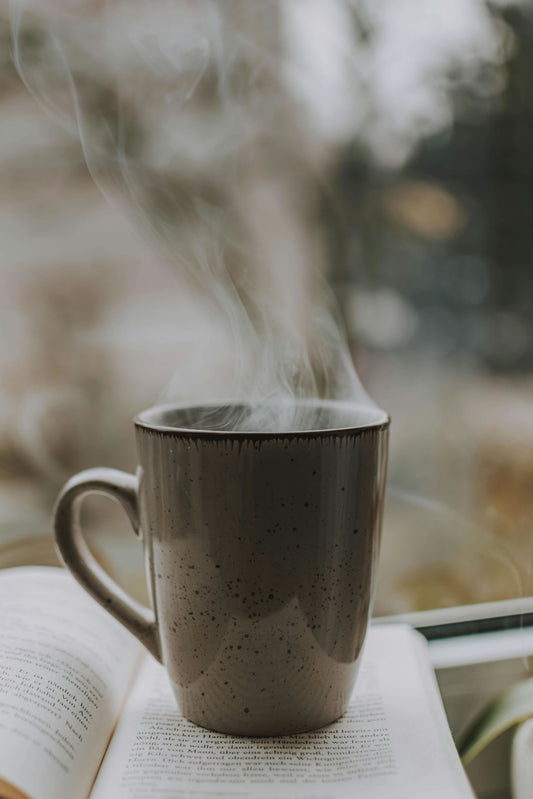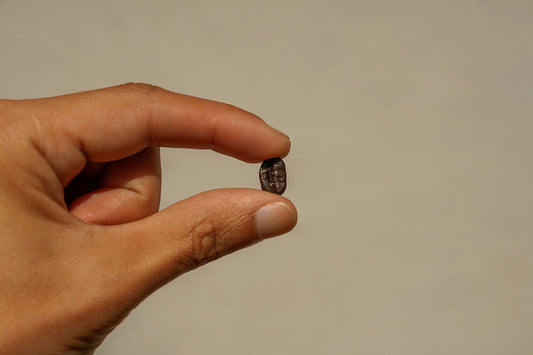Both coffee beverages were invented in Italy. The name macchiato, which means "marked coffee," alludes to the reduced amount of milk used in the beverage. In Italian, a "café latte" is simply "milk coffee," hence the name. The extra layer of frothed milk on top and the larger quantity of milk inside explain this.
Macchiatos and lattes both have steamed milk added to an espresso base. We hope this guide clears up any confusion you may have between a macchiato and a latte. So that you can order with confidence and really impress your barista, we break down the ingredients, ratios, and flavors that go into each drink.
What is a Latte?
This espresso and milk beverage is easy to make. A latte consists of strong espresso shots mixed with a large amount of steamed milk and topped with foam. Individualization of one's coffee is a perk for most consumers. This is why lattes have become so popular; they are simple to customize. You can personalize your drink by adding one of many different flavors. With the advent of latte machines, they're also incredibly simple to prepare.
Although most cafes only offer one size of latte, typically between 8 and 12 ounces in volume, larger sizes of lattes are becoming increasingly common. In most cases, the amount of espresso in each size is the same; the difference is in the amount of milk added. This makes the smaller sizes taste more strongly of coffee and the larger sizes taste more subtly of coffee.
In addition, latte art, which is a design made in espresso by the barista's pouring technique, will be added to your latte at most trendy coffee shops. Latte art doesn't change the taste of your drink and doesn't require any special equipment or ingredients, but it does elevate the experience by adding a touch of class and beauty.
A lot of places sweeten their lattes with different flavors to make them more interesting to customers. Purists, however, will insist that the ideal flavor profile is achieved by combining high-quality medium-to-dark roast coffee with high-quality whole milk. On hot summer days, a glass of latte served over ice is a refreshing alternative.
How much caffeine is in a latte?
Caffeine content ranges from about 80mg in small/medium lattes to about 120mg in extra-large lattes. It's worth keeping in mind that while this is the same for a macchiato, your latte will be much bigger and contain significantly more milk.
What is a Macchiato?
As might be expected from the coffee gods themselves, Italians created this straightforward yet potent beverage. If the one you order at a cafe is loaded with sugary syrups and sauces, it isn't the real deal. The Italians, needless to say, would not be pleased. Macchiatos were created to amplify, not mask, the taste of espresso.
What, then, constitutes a genuine macchiato? Stained or marked is what "macchiato" means in Italian. An "espresso macchiato," the modern iteration of the macchiato, consists of nothing more than an espresso topped with a dollop of steamed milk and a thin layer of foam. This beverage provides you with the robust espresso taste you crave, tempered by the creamy addition of milk. While the flavor is substantial, the average package size is only two to four ounces.
It's important to note that different macchiatos, like the caramel macchiato and the latte macchiato, are promoted by different coffee shops. These variants deviate from the classic espresso macchiato in taste and texture due to the addition of flavored syrups, caramel, or extra milk. This significant variation can be very perplexing when ordering a macchiato, so it's important to enquire about the specifics of the barista's macchiato preparation before placing an order.
How much caffeine is in a macchiato?
The average amount of caffeine in a small/medium macchiato is 80mg, while a large contains around 120mg.
Variations and Customizations
Macchiato Variations
A shot of espresso is topped with one or two teaspoons of foamed milk to create an espresso macchiato, which is known for its robust and bitter flavor. Several variants are available to meet a wide range of tastes. The caramel macchiato is a popular option because caramel syrup is added to espresso before the milk foam. The iced caramel macchiato is another alternative; it consists of espresso poured over ice and then topped with frothed milk and caramel syrup. If you like your coffee strong, try ordering a doppio (two shots) or a ristretto (a shorter espresso extraction).
Latte Variations
Sixty percent steamed milk, twenty percent espresso, and twenty percent milk foam make up a latte. In comparison to a macchiato, the flavor is less intense. The milk foam in a latte macchiato is added before the espresso, giving the drink a layered appearance and a slightly different flavor. You can get lattes with either one or two shots of coffee, if that's how strong you like your java. For a more customized brew, you can add caramel syrup or another sweetener to your latte, just one of many flavorings available.
Key Differences
Ingredients and Components
A Macchiato is an espresso drink to which a touch of steamed milk is added. A classic macchiato has equal parts milk and coffee. The Latte, on the other hand, is a combination of espresso, steamed milk, and microfoam. The standard ratio of milk to coffee in a latte is 2:1.
Flavor Profile
Lattes have a more balanced flavor due to the higher milk content, while macchiatos tend to be more espresso-forward, bringing out the coffee's flavors. Because of this equilibrium, lattes are a versatile and popular coffee drink that can easily incorporate flavor add-ins.
Texture and Feel
A macchiato has a lighter body, with the espresso flavor taking center stage. In contrast, the combination of milk and microfoam gives lattes their signature velvety smoothness. Coffee novices may find lattes more enjoyable because of the creamy texture and mild flavor profile.
Caffeine Content
Caffeine-wise, a 16-ounce latte has about the same amount as a cappuccino, which is about 173 mg. In contrast, a 2-ounce serving of macchiato contains only about 85 mg of caffeine. Those trying to control their caffeine consumption throughout the day should take note of this distinction.
In conclusion, the ingredients, proportions, flavor profiles, textures, and caffeine content of a macchiato and latte are the primary distinguishing factors between the two. Lattes are creamier and more well-balanced due to their higher milk content and microfoam layer, while macchiatos are more espresso-forward but thinner in texture and contain less caffeine.
Nutritional Information
Calories
The calorie count of a macchiato and a latte are different. Macchiato has about 5 calories per fluid ounce. A similar amount of latte, on the other hand, will only have about 8 calories. Lattes have more calories because they contain more steamed milk than other coffee beverages.
Fat Content
There is some variation, albeit not a huge one, in the amount of fat found in these drinks. Fat content per fluid ounce is lower in a macchiato (0.28 g) than in a latte (0.34 g). The main difference between lattes and macchiatos is the use of steamed milk and milk foam in lattes.
Protein Content
The protein content of lattes is significantly higher than that of macchiatos. Latte has 0.55 grams of protein per fluid ounce, while macchiato has only 0.26 grams per ounce. This is because more milk is typically used when making lattes, which increases the protein content.
Tasting the Difference
Taste and Flavor Profile
The primary distinction between a macchiato and a latte is one of flavor. The espresso in a macchiato is the star of the show, with some steamed or foamed milk on top. The resulting flavor is robust and full-bodied, drawing attention to espresso's distinctive qualities. Depending on the bean used and the roasting process, a macchiato's flavor can range from slightly bitter to slightly sweet.
A latte, on the other hand, is a more well-rounded beverage because it combines espresso with more steamed milk. When compared to a macchiato, the flavor created by this mixture is softer and slightly sweeter. To adjust the sweetness and flavor to your liking, you can add flavored syrups to your latte, like vanilla or caramel.
Texture and Mouthfeel
Another key distinction between these two well-liked drinks is in their texture and mouthfeel. A macchiato has a stronger espresso flavor and may be more assertive. The lack of milk makes this beverage much more watery than a traditional latte.
On the other hand, steamed milk gives lattes their signature velvety creaminess. Unlike the strong sensation of a macchiato, this coffee's texture is soothing and smooth in the mouth. Because of this quality, lattes are frequently ordered by coffee drinkers who favor mellower and more comforting beverages.
The macchiato's flavor, flavor profile, and texture set it apart from the latte. A latte creates a smoother, slightly sweeter taste with more layers of milk than a macchiato, showcasing the rich, bold espresso flavor with just a touch of milk. Which coffee drink one prefers depends on personal taste, but it's clear that both have their own advantages and benefits.
Coffee in Beauty and Wellness
At Juju Blends, coffee lovers are invited to a fantastical world of reality in which traditional café lattes have been elevated by the skillful fusion of indulgent and healthful ingredients. In addition to satisfying your taste buds, their products are designed to boost your health and well-being.
Juju Blends Collagen Coffee Latte
You can drink coffee that tastes like it came from a café whenever and wherever you want, and it will make you look and feel better. If you drink a cup of our sugar-free latte, you don't have to feel bad about how good it smells and tastes. Get rid of tiredness and sluggishness with a cup of latte made by an Italian barista in the traditional way, with high-quality coffee beans. Find out how to get smooth, firm, and glowing skin by injecting four different types of collagen to fight dryness, fine lines, and sagging. Say goodbye to hair loss and nails that break easily. This will help them stay strong and healthy. Taking care of your bones, joints, and muscles will also make you feel less pain, inflammation, and stiffness. Not only is it tasty, but it also helps you get rid of toxins, digest food, and grow healthy bacteria in your gut. In this case, coffee is more than just a pick-me-up; it's part of a daily self-care routine.
Juju Blends Moringa Matcha Latte
You can still enjoy the great flavor of your favorite creamy matcha latte, but without the sugar. Instead, we used malunggay extract, which is a 100% natural sweetener. Kyoto matcha is made with the best tea leaves and is processed in a special way to keep as many of the tea's healthy nutrients in each serving as possible. This mix of matcha and moringa is a rich, creamy super drink with anti-inflammatory, antibacterial, and immunity-boosting properties. It promises to lift your mood, give you steady energy, and sharpen your mind. Take advantage of how matcha and malunggay work together to improve your health and keep you from getting sick. One cup a day is a great way to take care of your health because it not only helps your digestive system and gets rid of toxins, but it also tastes great.
Perfect Pairings
If you want to take your coffee drinking to the next level, try ordering a macchiato or latte along with some tasty snacks. Some delicious options for snacks are listed below.
- Biscotti: Biscotti, which comes in a variety of crunchy textures and flavors like almond and chocolate, is a great option. Use it as a dipping device for your cappuccino or latte.
- Croissants: You can't go wrong with a latte and a buttery, flaky croissant. A plain croissant's subtle sweetness and airiness pair well with coffee's rich creaminess.
- Chocolate: Both coffee and tea taste great with dark chocolate or chocolate-covered espresso beans. Dark chocolate's bitterness pairs well with coffee's richness.
- Muffins: Blueberry, banana nut, and coffee cake muffins are all good options. Their sweetness and tender texture pair wonderfully with coffee.
- Cheese and Crackers: Try some mild cheese and whole-grain crackers with your coffee if you're more of a savory person. Warmth from the beverage and the richness of the cheese can make for a comforting meal.
- Nuts: Crunchy and salty roasted nuts like almonds, cashews, or pistachios are a great complement to a cup of coffee. You can also choose them if you need a quick burst of energy.
- Fruit: If you're looking for a healthy and refreshing addition to your coffee, try some fresh fruit like apple slices, strawberries, or a fruit salad.
In the end, it's all about what you like to eat with your macchiato or latte. Discover what goes best with your coffee by trying out various combinations.
FAQs
Is a macchiato stronger than a latte?
Yes, a macchiato is stronger than a latte due to its higher coffee-to-milk ratio. "Macchiato" means "stained" in Italian, signifying espresso with a small amount of milk.
What's the difference between an iced latte and an iced macchiato?
An iced latte blends espresso and cold milk, while an iced macchiato features espresso "stained" with a small amount of cold milk, resulting in a more pronounced coffee flavor.
How does the caffeine content compare between a macchiato and a latte?
Macchiatos generally have more caffeine than lattes because of the higher coffee concentration. However, caffeine levels can vary depending on factors like size and espresso shots used.
Why is a latte often creamier than a macchiato?
Lattes are creamier due to the larger milk-to-espresso ratio, resulting in a milder flavor. In contrast, macchiatos have less milk and a stronger coffee taste.
Why is layering more noticeable in a macchiato than a latte?
Layering in macchiatos is pronounced because the milk and espresso are less mixed, creating distinct layers. Lattes, on the other hand, blend espresso and milk more evenly, resulting in a smoother appearance.
Conclusion
Macchiatos have a higher coffee-to-milk ratio than lattes, making them significantly more potent than lattes. Macchiato literally translates to "stained" in Italian, and refers to espresso that has been lightly topped with milk. Creamier and milder in flavor, lattes have more steamed milk than cappuccinos. Macchiatos also have a higher caffeine concentration than other coffee drinks. A macchiato is visually distinct because the layers or separation are more apparent. Given these variations, picking a macchiato or latte depends on personal preferences for caffeine content and milkiness.




